Some women who live code
08/12/2016
Amy Alexander, USA (visuals and sound)
Annie Goh DE/UK
Chez Sargent (visualist), UK
Dorien Schampaert, (aka Belisha Beacon) UK
Dragica Kahlina CH
Echo Ho, DE
Emma Cocker, UK (art + research)
Esther Alzate Romero, DE
Kate Sicchio (dance), USA
Libertad Figueroa MX
Lina Bautista, CO/ESP
Lucy Cheesman (aka Heavy Lifting), UK
Joana Chicau, NL
Jude Cowan Montague, UK
Marije Baalman, NL
Norah Lorway
Joanne Armitage, UK
Shelly Knotts, UK
sininho
Sonia Paço-Rocchia (live coding web, sound and visual), CA
OFFAL, a women laptop band that uses some live coding
Renate Weisser
PB_UP, DE
Valerie known by libertad, MX
Tanya Goncalves, CA
If you are aware of ways to improve this list (websites, names, details), please do contact me.
First modified recorder for live electronics music
01/07/2012
I finally turned this bad recorder I found in a second hand shop in a "electric" recorder.
As I was telling here I got an inner microphone for the bassoon. I had the idea to try to use this microphone on other wind instruments, just to see how it would sound. So, for a first try, I got a student second hand recorder at 1$ in a second hand shop. I tried to imitate the modification I have on my modified bassoon bocal. The main problem I got is that the flute is made of plastic and it melted when I made the hole. So, it doesn’t look as pretty as I would like for a better instrument, but it works.
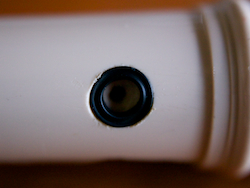
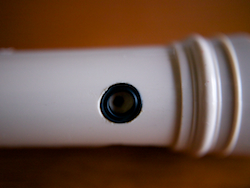
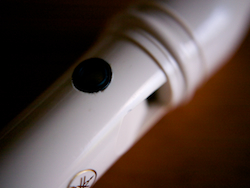
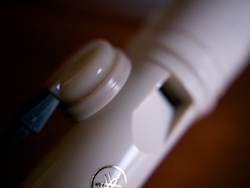
It works, and it sounds better than I expected (see video here). So, I just bought a YRT304B sopranino recorder for the next step. Looking forward to receiving it.
"Electric" bassoon
01/07/2012
If you know a bit what I do with the bassoon, you probably realised that I have, what some people call, an "electric" bassoon. I think this term is used because I can actually plug the bassoon with a 1/4 jack as an electric guitar would do. But, in fact, that is the only common part with the electric guitar. I actually have a normal bassoon with a modified bocal.

I have a pick-up on my bocal. Well, actually, it is often call a pick-up, but it has nothing to do with a electro magnetic pick-up from an electric guitar nor a piezo-electric microphone that we sometime call pick-ups. Well, actually, has it takes air vibration, it should be call a microphone, or maybe an inner-microphone, a transducer. I have a Telex.
The modified bocal got a hole in it, before the first octave-key hole, first hole of the instrument. So, the microphone "hear" from the inside of the instrument. You can understand that with this idea, you get a lot less outside noise, but, you do get some. And, you can understand that as we never hear an instrument from inside, the sound is not the sound we are used to hear, but, it is good enough if you want to torture it with effects.
Here, is a piece for bassoon in which I used that bocal with an inner microphone. But, for the recording of the instrument, I had a standard microphone too.
Logical Bassoon
J’ai eu le plaisir de rencontrer Giles Brindley, le concepteur-inventeur du Logical Bassoon et d’entendre la sixième version de l’instrument. Ce dernier logical bassoon est un instrument que je mettrais dans la famille du Theremin et de l’Ondes Martenot, mais à la différence que celui-ci est basé sur les principes d’un instrument à vent.
13/06/2007
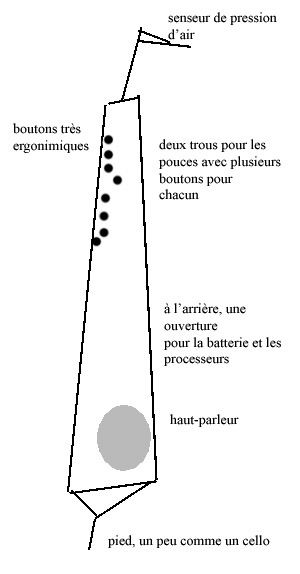 Tout d’abord la façon de le tenir est très près de la clarinette basse, un pied au sol, entre les jambes, très confortable. Les mains ont une position rapprochée et naturelle, ce qui est le but même du concepteur. Les nuances et les attaques du logical bassoon sont donc contrôlé à l’aide de la pression d’air, et le son est produit pas un processeur d’époque qui permet de faire tourner 12 oscillateurs pour faire un son qui se rapproche tant que possible de celui du basson.
Tout d’abord la façon de le tenir est très près de la clarinette basse, un pied au sol, entre les jambes, très confortable. Les mains ont une position rapprochée et naturelle, ce qui est le but même du concepteur. Les nuances et les attaques du logical bassoon sont donc contrôlé à l’aide de la pression d’air, et le son est produit pas un processeur d’époque qui permet de faire tourner 12 oscillateurs pour faire un son qui se rapproche tant que possible de celui du basson.
Le basson étant l’instrument à vent avec les doigtés les plus biscornus, le pouce gauche ayant de 8 à 10 clefs (selon le modèle de basson) la main gauche étant aussi la main où s’appuie l’instrument, et les doigtés de fourches étant très courant, il y a des moments où l’apprenti bassoniste se demande s’il apprend à jouer ou à tricher... Giles Brindeley étant un ancien bassoniste qui a donc été confronté à ces doigtés s’est penché sur la question. Les premières versions du Logigal Bassoon avaient pour but de simplifier le doigté du basson, celui-ci avait un mécanisme électronique au lieu de mécanique pour ouvrir et fermer les trous du basson.
(link) Paper: The logical bassoon, by Giles Brindley
(link) Giles Brindley: Presentation Is (Not Really) Everything
Autant ces instruments du vingtième siècle (Theremin, Ondes Martenot et Logical Bassoon) ont des approches nouvelles de l’interface instrumental, autant celle-ci peut parfois limiter à certains styles de musique très particuliers. Mais je crois que la plus grosse lacune de ces instruments est leurs timbres limités, souvent pauvres, ce qui ne leur donne pas beaucoup de chance au siècle du timbre. Si vous pensez au développement d’un autre instrument du vingtième siècle beaucoup plus penché sur le timbre que sur l’interface de l’instrument, la guitare électrique, vous vous rendez compte que cela en fait un instrument beaucoup plus utilisé.










